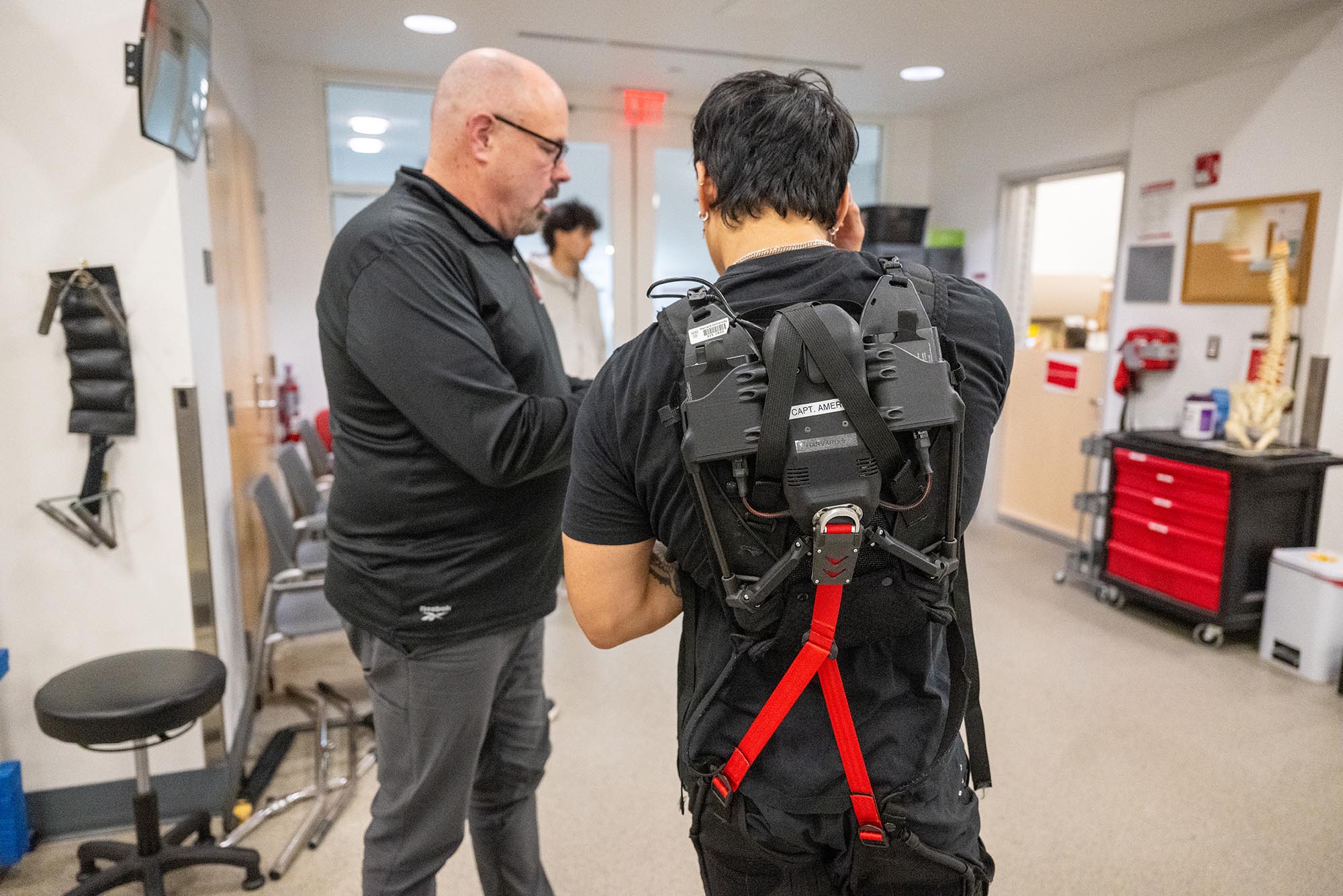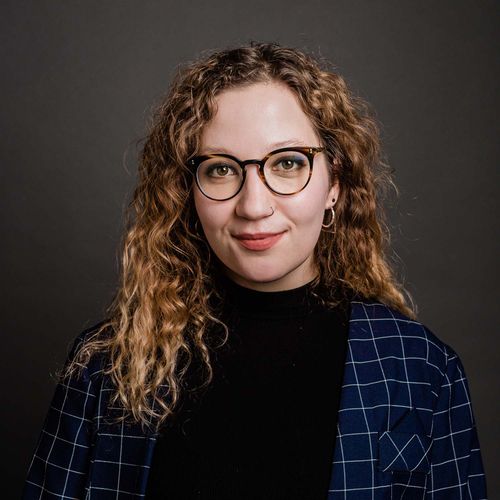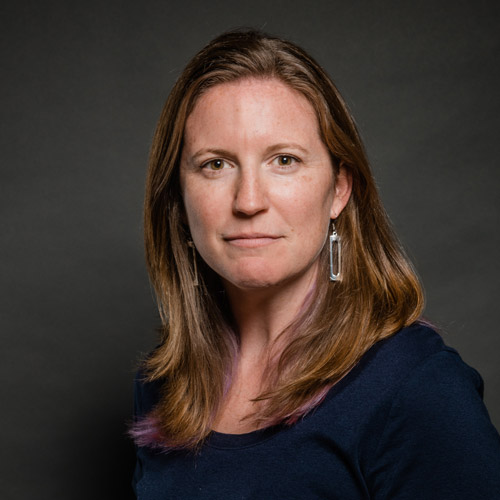Finding Non-Opioid Solutions for Low Back Pain
A robotic exosuit trial is the latest research coming out of the BU Physical Therapy Center

BU Physical Therapy Center staffer Andy Nhiv—under the watchful eye of BU researcher Trace Sears—demonstrates using an exosuit to assist with lifting weights; the technology could help those experiencing low back pain.
Finding Non-Opioid Solutions for Low Back Pain
A robotic exosuit trial is the latest research coming out of the BU Physical Therapy Center
At some point in your life, you’ll probably experience low back pain.
Low back pain (LBP), acute or chronic pain in the lower back region, is the most common contributor to disability around the world. It’s one of the top reasons Americans visit their primary care doctors every year and an affliction that spares almost no one: National Library of Medicine estimates say a whopping 80 percent of Americans in their lifetime will experience an episode of LBP that impedes their ability to function.
Low back pain is also one of the primary contributors to America’s opioid crisis.
“We know that a lot of folks who end up addicted to opioids or overdosing on opioids start off with low back pain,” says Diane Dalton, a Boston University Sargent College of Health & Rehabilitation Sciences clinical associate professor of physical therapy.
Dalton, also a physical therapist at the Sargent-affiliated BU Physical Therapy Center (BUPTC)—part of BU’s Ryan Center for Sports Medicine—is among the researchers working on clinical, non-opioid solutions for low back pain. One solution? A robotic backpack.
Dalton is the clinical lead for a joint BU-Harvard University trial through the Back Pain Consortium (BACPAC) Research Program, part of the National Institutes of Health’s Helping to End Addiction Long-term (HEAL) Initiative. The trial, run out of BUPTC, tests the efficacy of using exosuit technology to augment the care of patients experiencing prolonged low back pain.
At first glance, the exosuit resembles a hydration backpack that a long-distance runner or hiker would wear. Once on your back, the exosuit—based on tech first developed at Harvard and refined at Sargent—straps across your chest and stomach, with additional straps around your thighs. Wires crisscross around the back of the exosuit.

A researcher turns on the device. Nothing happens at first—until you perform a squat. As you bend your knees and push your hips back, the exosuit’s mechanics help lower you down into a squat position. You move to straighten up and—whoosh!—the suit helps shoot you back to a standing position, with minimal strain on your back.
Sargent’s Louis Awad, an associate professor of physical therapy and the trial’s principal investigator, was working at Sargent and Harvard’s Wyss Institute for Biologically Inspired Engineering when he first observed the exosuit’s clinical potential. Later, he would experience the benefits himself: Awad reaggravated an old back injury in 2020. Normally, he says, a flare-up would put him in bed for a few days. Instead, he strapped on an exosuit. With the device’s help, he says, “I was up and moving on day one.”
That’s precisely the trajectory BUPTC wants for its trial participants—and for any future exosuit users.
“I view the tech as a partner in value-based care, where the goal is not just better outcomes—i.e., less pain and disability—but also to achieve these outcomes faster, and with lower recurrence rates,” Awad says.
Patient-Forward Research
On a recent weekday afternoon, BUPTC—which is open to the general public and the University community—is buzzing with clinicians and patients. The clinicians—including residents and fellows, and 19 full-time therapists, many of whom also teach at Sargent—lead patients through exercises on a gym’s worth of equipment. Patients range from young to old, with various levels of physical capability. The patients in the center today make up some of the almost 27,000 patient visits BUPTC has in a year.
The center is unique among its peers, says director James Camarinos (Sargent’07,’09).
It’s highly uncommon for a physical therapy doctoral program to have its own clinic to train students. It’s even rarer for a university-related clinic to be completely self-sustaining (BUPTC is funded by its client services, according to Camarinos). And to help run research trials on top of all that?
“It’s a pretty aspirational clinic,” says Camarinos, who’s also the director of Sargent’s Orthopaedic Physical Therapy Residency program. “We have to do all of the things a private business would do, while also fulfilling our academic obligations.”
Everything that happens in the center is also a direct application of what students learn in their classes, he stresses. Research, then, is a natural extension of the classroom: “It’s not just about implementing what we know, but also trying to advance the science of what we don’t know,” Camarinos says.
The BACPAC trial is just the latest entry in a series of BUPTC-supported research. A previous research trial involving wearable tech, led by Deepak Kumar, a Sargent associate professor of physical therapy, tested AI-powered sensors’ ability to assess the movement patterns of patients with knee osteoarthritis in and out of clinical settings. The trial’s findings, published in an American College of Rheumatology journal, demonstrated that the wearable sensors were reliable when used by patients at home—opening the door to more-accessible care for all, but especially individuals experiencing mobility issues.
Many ingredients go into helping people get better, according to Camarinos. One is delivering care that has good research behind it, he says. Another is simply easing the burden on patients. While that can involve high-tech solutions, it also includes the more mundane, like helping patients navigate their insurance.
“In the truest sense, part of what gets people better is that they don’t dread coming to a place like this,” Camarinos says. “My hope is that patients would tell you that they like to come here, and that they really feel taken care of.”
Up and Moving
While regular patients work on everything from postsurgical rehabilitation to a return to sports, Harvard researcher Marija Bakoc is taking exosuit trial participant Jonathan Li (CGS’23, Pardee’25) through a series of movements. Li was recruited for the trial after coming to the center with moderate back pain when lifting weights.
After a warm-up, each trial session starts with calibrating the exosuit to a participant’s low back pain level. (More pain means more support from the suit.) Then the data portion begins. Li bends, twists, then walks the length of a hallway. Bakoc asks him to rate the difficulty for each set of movements—meant to replicate different ways someone would move throughout a day—and makes notes on her tablet. Later, she’ll have Li perform the same movements with the device turned off.

The goal is to create quantifiable metrics for how quickly you can observe changes in someone’s mobility, explains senior physical therapist Trace Sears (Sargent’92,’93,’05), the trial’s clinical research physical therapist. The exercises also help improve the exosuit tech: ultimately, the exosuit should be able to recognize if someone is experiencing low back pain, based on their movements, and adjust the support level accordingly.
It’s hardly surprising that this trial landed at BUPTC, Sears says.
“For a number of years now, we’ve been on the leading edge of conceptualizing how we treat people with low back pain,” he says.
For one, opioids don’t need to be the first line of attack for someone experiencing LBP, Sears says. Research shows that physical therapy intervention, or getting people up and moving earlier in the recovery process, is highly effective for reducing pain and restoring function. But movement can be a hard sell for someone who’s hurting.
That’s why the exosuit could be a game changer for enhancing care.
“Someone who was maybe afraid to try [an activity] before, I’ve discovered, has been not afraid to try it with the exosuit on,” Sears says. “They get the experience of, ‘Oh, I can do this—it doesn’t hurt as much as I thought it would!’ and suddenly we’re moving them in the right direction.”
This research was supported by the National Institutes of Health through the NIH HEAL Initiative. The Back Pain Consortium (BACPAC) Research Program is administered by the National Institute of Arthritis and Musculoskeletal and Skin Diseases. The project also received funding from BU’s Neuromotor Recovery Laboratory.


Comments & Discussion
Boston University moderates comments to facilitate an informed, substantive, civil conversation. Abusive, profane, self-promotional, misleading, incoherent or off-topic comments will be rejected. Moderators are staffed during regular business hours (EST) and can only accept comments written in English. Statistics or facts must include a citation or a link to the citation.